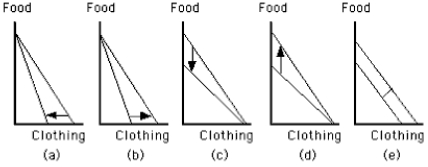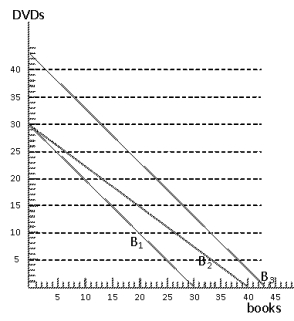A) increase in the price of clams
B) increase in the price of mussels
C) decrease in the price of clams
D) decrease in the price of mussels
E) increase in the amount the consumer can spend
G) A) and C)
Correct Answer

verified
Correct Answer
verified
Multiple Choice
Exhibit 6-29  -Which graph in Exhibit 6-29 shows the effect of an increase in the price of clothing and a decrease in the price of food?
-Which graph in Exhibit 6-29 shows the effect of an increase in the price of clothing and a decrease in the price of food?
A) Graph a
B) Graph b
C) Graph c
D) Graph d
E) none of these
G) B) and D)
Correct Answer

verified
Correct Answer
verified
Multiple Choice
Within the framework of indifference curve analysis, what prevents the individual from purchasing more of all goods?
A) Legal prohibitions
B) Budget constraint
C) The slope of the indifference curve
D) Psychological considerations
E) Diminishing marginal utility
G) A) and B)
Correct Answer

verified
Correct Answer
verified
Multiple Choice
Exhibit 6-31  -Assume that a consumer is initially in equilibrium at point a in Exhibit 6-31. Then the price of good B falls. The movement from point c to point b represents
-Assume that a consumer is initially in equilibrium at point a in Exhibit 6-31. Then the price of good B falls. The movement from point c to point b represents
A) the substitution effect
B) the income effect
C) the substitution effect minus the income effect
D) the sum of the substitution and income effects
E) the income effect minus the substitution effect
G) B) and E)
Correct Answer

verified
Correct Answer
verified
True/False
If two goods have the same price, a consumer will buy equal quantities of those two goods.
B) False
Correct Answer

verified
Correct Answer
verified
Multiple Choice
The marginal rate of substitution indicates
A) how much of one good a consumer is willing to give up to get one more unit of another good while remaining equally satisfied
B) how much of a good a consumer can receive for $1 while remaining equally satisfied
C) the tendency of a consumer to substitute lower-priced goods for a good whose price has increased
D) the limits of utility analysis
E) the basis of consumer surplus
G) B) and D)
Correct Answer

verified
Correct Answer
verified
Multiple Choice
What would happen to the budget line if the price of orange juice increased and orange juice is measured on the vertical axis?
A) It would shift to the right.
B) It would rotate outward along the horizontal axis.
C) It would rotate inward along the horizontal axis.
D) It would rotate outward along the vertical axis.
E) It would rotate inward along the vertical axis.
G) C) and D)
Correct Answer

verified
Correct Answer
verified
Multiple Choice
Exhibit 6-26  -Consider Exhibit 6-26. Three budget lines are shown. Which of the following statements is true about the budget lines?
-Consider Exhibit 6-26. Three budget lines are shown. Which of the following statements is true about the budget lines?
A) Budget line B2 reflects the same income and price for DVDs as budget line B1 but a higher price for books.
B) Budget line B3 reflects a higher income but the same price for both books and DVDs as budget line B2.
C) Budget line B3 reflects higher income and the same prices for both books and DVDs as budget line B1.
D) Budget line B1 reflects lower income than budget line B2.
E) Budget line B3 reflects a lower price ration than budget line B3.
G) A) and B)
Correct Answer

verified
Correct Answer
verified
Showing 101 - 108 of 108
Related Exams